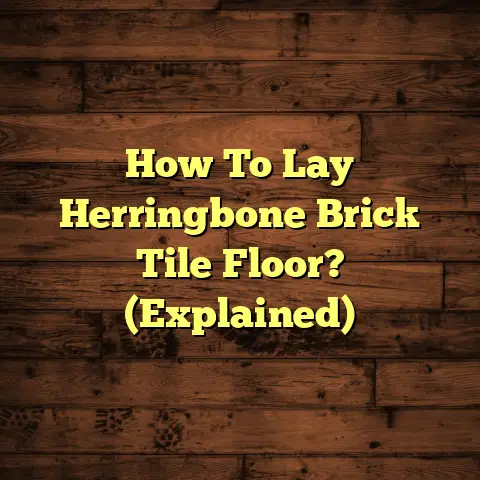Herringbone Hardwood: How To Get It Right? (1 Tiny Mistake!)
There’s something truly magical about herringbone hardwood flooring.
It’s not just a floor; it’s a statement, a piece of art underfoot.
It’s a pattern that dances with light, adds depth, and whispers stories of timeless elegance.
Think Parisian apartments, grand estates, and even modern lofts – herringbone fits right in.
But here’s the thing:
While herringbone hardwood can elevate any room, there’s one tiny mistake that can completely undermine its beauty.
It’s like a single off-key note in a symphony, or a misplaced brushstroke in a masterpiece.
Stick with me, and I’ll show you how to avoid this pitfall and achieve herringbone perfection.
Section 1: Understanding Herringbone Hardwood
So, what exactly is herringbone hardwood?
Simply put, it’s a pattern created by arranging rectangular wood planks in a zigzag formation.
Think of it as a series of V’s interlocking to form a visually stunning design.
The name “herringbone” comes from its resemblance to the skeleton of a herring fish.
It’s a classic parquet style, but distinct from other parquet patterns like chevron (where the ends of the planks are cut at an angle to form a continuous zigzag line).
Herringbone offers a more broken, interrupted visual, which many find more interesting and dynamic.
Traditional vs. Modern:
- Traditional: Often features smaller planks
and a more intricate, detailed pattern. - Modern: Tends to use larger planks for a
bolder, more contemporary look.
Material Matters:
The wood species you choose dramatically affects the overall aesthetic.
-
Oak: A classic choice, known for its
durability and beautiful grain patterns.It’s versatile and can be stained in a wide
range of colors.
* Maple: Offers a cleaner, more uniform
look with a subtle grain.It’s a great option for modern spaces.
* Walnut: Rich and luxurious, with a deep
brown hue and striking grain variations.It adds warmth and sophistication to any room.
Herringbone in Different Design Themes:
- Rustic: Pair oak herringbone with a matte
finish and distressed details for a cozy,
farmhouse feel. - Industrial: Use reclaimed wood herringbone
with a dark stain and exposed nail heads for
an edgy, urban vibe. - Contemporary: Opt for maple or light-toned
oak herringbone with a glossy finish for a
sleek, minimalist aesthetic.
Section 2: The Aesthetic Appeal of Herringbone Hardwood
Okay, let’s dive deeper into why herringbone is so visually captivating.
Creating Visual Interest:
The geometric design of herringbone is inherently eye-catching.
It draws the eye across the room, creating focal points and adding a sense of dynamism.
The pattern itself becomes a design element, elevating the entire space.
Enhancing Space Perception:
Herringbone can actually manipulate how we perceive the size and shape of a room.
- Small Spaces: Running the pattern parallel
to the longest wall can visually lengthen the
room, making it feel more spacious. - Large Spaces: Orienting the pattern
diagonally can create a sense of coziness and
break up the monotony of a large, open area.
Color and Finish Options:
The choice of wood stain, finish, and sheen can completely transform the look of herringbone flooring.
- Light Stains: Create a bright, airy feel,
perfect for modern or Scandinavian-inspired
spaces. - Dark Stains: Add drama and sophistication,
ideal for formal living rooms or dining areas. - Matte Finish: Offers a natural, understated
look that complements rustic or contemporary
designs. - Glossy Finish: Creates a luxurious,
reflective surface that adds a touch of glamour.
Successful Installations:
- Living Room: A large-scale oak herringbone
floor with a natural stain can create a warm
and inviting atmosphere. - Hallway: Running a smaller-scale herringbone
pattern lengthwise can visually lengthen a
narrow hallway. - Dining Area: Walnut herringbone with a dark
stain can add a touch of elegance and
sophistication to a formal dining room.
Section 3: Installation Insights for Perfect Aesthetics
Now, let’s talk about installation.
Proper installation is absolutely crucial for achieving the desired aesthetic outcomes with herringbone hardwood.
Subfloor Preparation:
A well-prepared subfloor is the foundation of any successful flooring installation.
It needs to be level, clean, and dry.
Any imperfections in the subfloor will telegraph through to the finished floor, creating an uneven surface and detracting from the overall aesthetic.
I always recommend checking the subfloor with a level and addressing any dips or humps before starting the installation.
Self-leveling compound can be used to create a perfectly smooth surface.
Layout Planning:
Careful layout planning is essential for achieving optimal visual impact.
Consider the shape of the room, the placement of furniture, and the direction of natural light.
Determine the focal point of the room and orient the herringbone pattern to draw the eye towards it.
I like to start by finding the center of the room and working outwards, ensuring that the pattern is symmetrical and balanced.
Alignment and Spacing:
Precise alignment of the herringbone pattern is absolutely critical for achieving a polished look.
Even the slightest misalignment can throw off the entire pattern and create a distracting visual imperfection.
Use spacers to maintain consistent spacing between the planks and ensure that the V’s are perfectly aligned.
A laser level can be a valuable tool for ensuring that the pattern is straight and true.
Anecdotes and Case Studies:
I once worked on a project where the homeowner insisted on skipping the subfloor preparation step.
The result was a disaster.
The finished floor was uneven and bumpy, and the herringbone pattern looked distorted and unprofessional.
We ended up having to tear out the entire floor and start over, which cost the homeowner a significant amount of time and money.
On another project, I spent extra time carefully planning the layout and ensuring that the pattern was perfectly aligned.
The homeowner was thrilled with the results.
The herringbone floor became the centerpiece of the room, adding a touch of elegance and sophistication that completely transformed the space.
Section 4: The One Tiny Mistake
Alright, drumroll please…
Let’s talk about the one tiny mistake that can ruin an otherwise stunning herringbone hardwood flooring installation.
Incorrect Cutting or Fitting:
This is it!
Improper cutting or fitting of the wood pieces can lead to uneven lines, gaps, or misalignments that detract from the intended visual harmony of the pattern.
It’s like a puzzle piece that doesn’t quite fit.
Even a small error can throw off the entire pattern and create a noticeable imperfection.
How This Mistake Manifests:
-
Uneven Lines: The lines of the herringbone
pattern should be crisp and straight.If the wood pieces are not cut accurately,
the lines will appear wavy or uneven.
* Gaps: Gaps between the wood pieces are
unsightly and can allow dirt and debris to
accumulate.
* Misalignments: If the wood pieces are not
aligned correctly, the V’s of the herringbone
pattern will appear crooked or distorted.
Impact on Aesthetic Appeal:
This tiny mistake can have a significant impact on the overall aesthetic appeal of the flooring.
It can make the floor look unprofessional, cheap, and unfinished.
It can also detract from the other design elements in the room and create a sense of visual discord.
How to Avoid This Mistake:
- Careful Planning: Take the time to carefully
plan the layout of the herringbone pattern
before you start cutting any wood. - Precise Measurement: Use accurate measuring
tools and double-check your measurements
before you make any cuts. - Sharp Tools: Use sharp, high-quality cutting
tools to ensure clean, precise cuts. - Practice: Practice cutting and fitting the
wood pieces on scrap material before you start
working on the actual floor. -
Patience: Don’t rush the installation
process.Take your time and pay attention to detail.
Conclusion
So, there you have it!
Herringbone hardwood flooring is a timeless and elegant choice that can elevate the design of any space.
But, as we’ve discussed, achieving herringbone perfection requires careful planning, precise installation, and attention to detail.
That one tiny mistake – incorrect cutting or fitting – can undermine all your hard work and detract from the beauty of the finished floor.
By avoiding this pitfall and following the tips I’ve shared, you can create a stunning herringbone floor that will be the envy of all your friends and neighbors.
Remember, a perfectly installed herringbone hardwood floor is more than just a floor.
It’s a statement, a piece of art, and a lasting investment in the beauty and value of your home.
So go ahead, embrace the elegance of herringbone and create a space that you’ll love for years to come!





